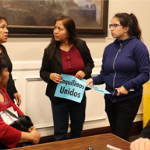Protests Rise As Santa Maria Refuses To Halt Immigrant Center

Community activists pledged Monday to continue fighting the construction of an immigrant processing center on the Central Coast, despite a bitterly contested vote in which a local city council advanced the project in the face of fervent public opposition.
“The fight is not over,” said Hazel Davalos, head of the Santa Maria chapter of Coastal Alliance United for a Sustainable Economy, an organization that helps working families in the region.
The federal government wants to replace an aging, dilapidated facility in Lompoc — a smattering of trailers that were installed on the grounds of a prison to process immigration cases. Since the trailers were installed in the 1970s, immigration has become a critical issue along the Central Coast, which is also one of the most important farming regions in the nation.
Each month, the U.S. Immigration and Customs Enforcement agency’s Central Coast office takes custody of about 100 people, virtually all of whom have completed criminal sentences at a local facility and are “potentially deportable.”
The government has proposed building a facility in Santa Maria where immigrants would be photographed and fingerprinted before being transported to Southern California or deported. It would hold no more than 13 people, and detainees typically would spend less than three hours there.
The proposal, however, has roiled Santa Maria, where immigrant labor is central to the economy and where three-quarters of the population is Latino. Activists have said the development would create a culture of fear, and the proposal has been countered with unusually large protests. The latest occurred last week, when more than 1,000 people swarmed a meeting to plead with the Santa Maria City Council to throw out the facility’s development permits.
The City Council voted 3 to 2 to reject the appeal and proceed with the development.
“No one should have to live in fear — real or perceived. All of us had to take that under consideration,” said City Councilman Jack Boysen, one of the three who voted in favor of the facility.
In the end, however, the facility will make the region safer, Boysen said. Despite public concerns, he said, construction of the facility will not lead to workplace raids.
“This is one more tool in our public safety toolbox,” he said. “These guys are out to get bad guys off the streets. This facility is going to make Santa Maria a safer place to live.”
ICE spokeswoman Lori Haley said Monday that the facility is expected to be completed in January.
“Our goal is to ensure that convicted criminals are not released back on the streets,” Haley said. “That’s going to benefit all the residents of Santa Maria. We’ll be good neighbors.”
Despite losing the vote, activists said they have been heartened by the debate and its effect on the community. The protests have brought together an unusual coalition, they said — growers, laborers, educators, business owners and civic leaders concerned about what might happen to the local economy if Santa Maria gets a reputation as being hostile to immigrants.
“They may have won the battle. But we are winning the war,” said Christina Fialho, co-founder and executive director of a nonprofit organization called Community Initiatives for Visiting Immigrants in Confinement, one of the groups arguing against the immigration facility.
Leaders of the opposition to the facility said they are considering a host of measures in the wake of the City Council’s vote, including legal action.
Davalos said her organization has registered 100 new voters in Santa Maria in the last month — the same number it typically helps to register in a year. She and other civic leaders have pledged to seize on the issue of the immigration facility to reshape the City Council so that it is more reflective of the community and responsive to working-class Latinos.
“There are a lot of people who have been woken up by this issue,” she said.














